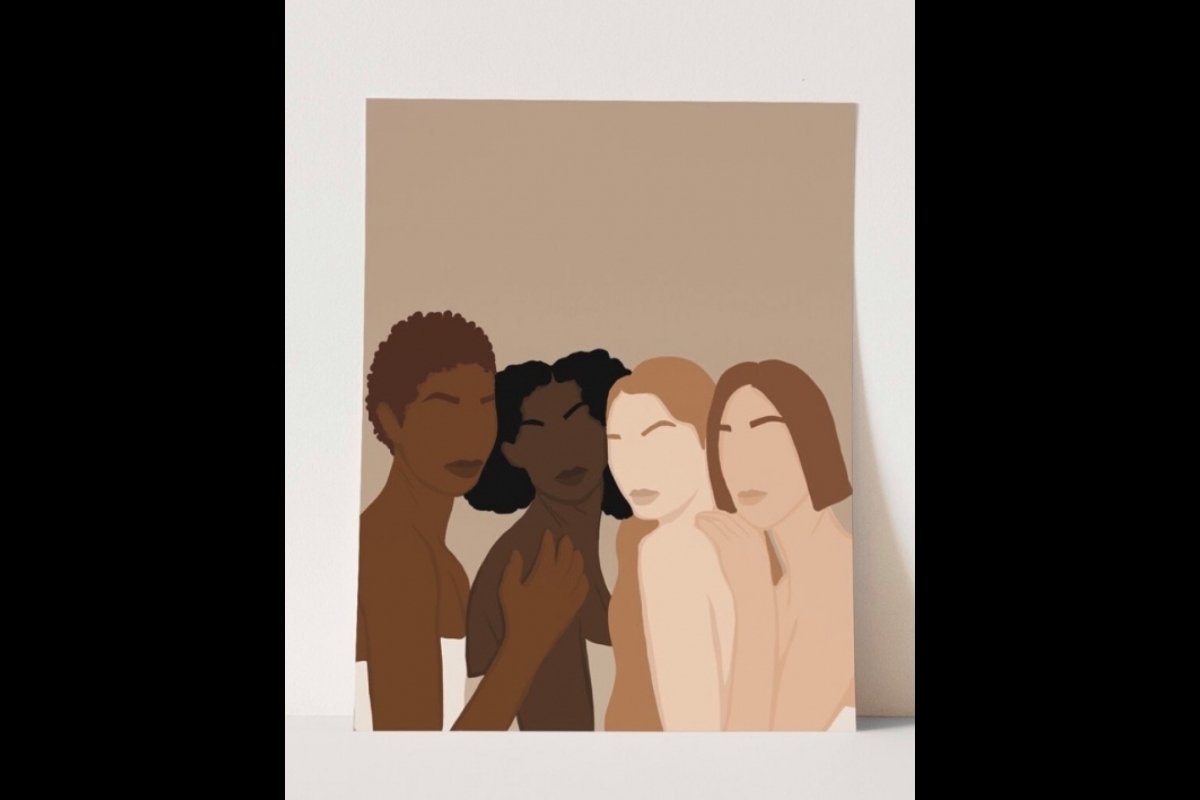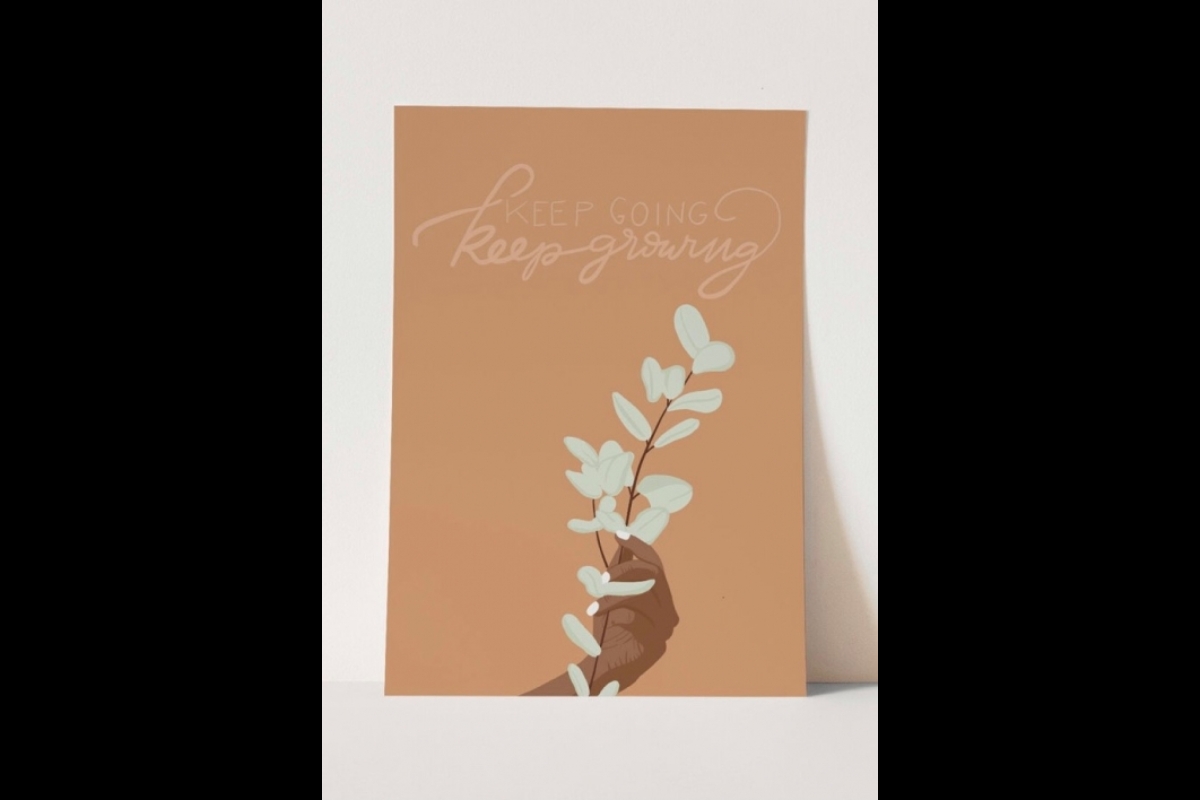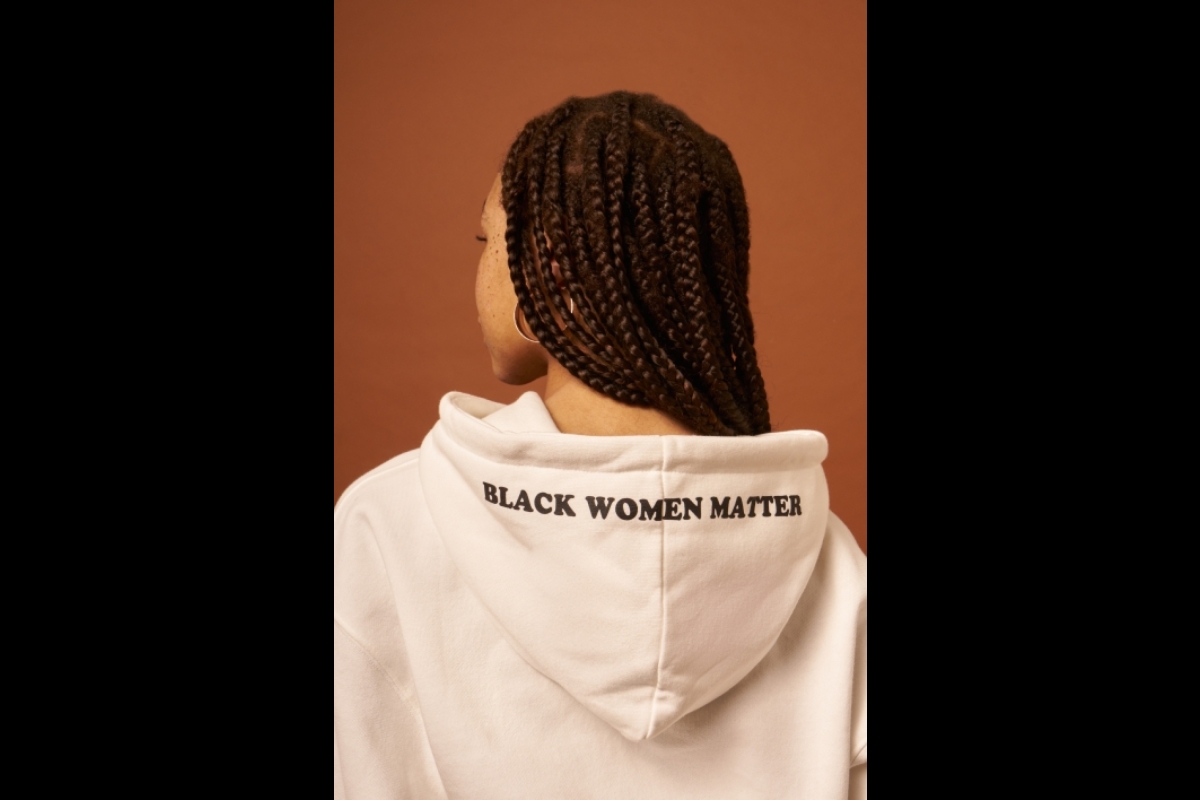Forever 21 clothing line features artwork by ASU graphic design alumna

Editor’s note: This story is featured in the 2021 year in review.
Earlier this month, Stormy Nesbit posted the ultimate series of selfies on Instagram: She was at the Quarter shopping plaza in Scottsdale, inside the Forever 21 store wearing a sweatshirt that she designed for the clothing brand. In another photo, she’s looking at her artwork on display in the front window of the West Elm furniture store just across the street.
“It was surreal,” said Nesbit, a Phoenix artist and designer who earned a master’s degree in visual communication design from Arizona State University in 2018. She designed several clothing items for Forever 21 for Black History Month.
“It was weird seeing my picture and my artwork and my name in stores and seeing people wearing my clothing.”
One of Nesbit’s sweatshirts for Forever 21 says “Black Women Matter” on the hood. Other items, including crew-neck sweatshirts and T-shirts, include uplifting sayings such as “Your uniqueness is your magic.” The clothing line, including plus sizes, debuted a few weeks ago and will remain until it sells out.
The West Elm in Scottsdale displayed Nesbit’s work as part of the company’s Fifteen Percent Pledge to promote the work of Black-owned businesses. Her prints aren’t for sale there but the display includes contact information to buy them.
The last year has been a whirlwind for Nesbit, who began posting her contemporary prints of Black life on her Instagram in 2019. Last summer, during the social-justice protests over the police killing of George Floyd, the country’s racial reckoning included a burst of attention on Black artists who were amplifying the Black Lives Matter movement.
That brought a huge focus on Nesbit’s work — and increased sales — even as she struggled emotionally with the killing of Floyd and its aftermath in her hometown of Minneapolis. She was featured in several national magazines and started working with national brands.
This year, her success has continued with the Forever 21 collaboration, and she’s grateful for the impact she’s made.
“It’s touching when I get messages from people saying that their child was teased for their hair or their skin color, but now they have clothing that looks like them that they can wear with confidence,” said Nesbit, who works as a graphic designer for PetSmart in addition to creating art for her online shop.
“Or a mother who says her son is an artist and sees someone like me being able to do these types of things and they feel it’s something they can do.”
Nesbit answered some questions from ASU News:
Question: Why did you choose ASU for graduate school?
Answer: I was offered the opportunity to be a graduate assistant for track and field, which led me to pursuing a master’s degree with the Herberger Institute for Design and the Arts, and I chose to do visual communication design.
I had been a collegiate athlete and I was now flipping the script to the business and design side of sports.
As part of the coaching staff, I did social media, all of the graphic design work and videography and photography, all while I was getting my master’s.
Q: What did you do after graduation?
A: I was still in the sports industry. I got a job with the Intercollegiate Tennis Association and had a similar role, as a digital media manager, graphic design, videography and photography. It’s literally across the street from ASU.
And now I’m a digital graphic designer for PetSmart.
Working in the sports realm, I could be working until 10 p.m. or traveling and didn’t have time off. It was hard to dedicate time to my art. With a corporate job, you don’t take your work home with you, and I had all this time, so I thought I’d start sharing my drawings.
I was always drawing and painting, but I wasn’t sharing it because I wasn’t confident in it. You worry about people critiquing it. I thought, “Let me share my artwork,” and that’s when it became something to fill my time outside of work.
Q: What is your medium?
A: Mostly it is digital right now because that is easiest to work in and process quickly. I’ve also gotten into paper crafting as well. But with my art and design background I can dabble in any medium.
My Instagram is all digital work because it’s quick for me to process and it’s not messy.
Q: Your work started getting a lot of attention from national media last summer in the midst of the social-justice protests. What was that like?
A: I say this a lot: The reason I got attention was because of something that was tragic. As an artist, I didn’t know how to use my voice. I couldn’t write a paragraph because that’s not my talent. So I used my art to speak for me, and with that came a lot of attention, because other people who didn’t have the words or who were exhausted of talking about this over and over again could share that.
I used my art to share experiences and communicate my frustration and solidarity over what was happening in the moment. And I gained a lot of traction as an artist.
I was able to be in a position where I could use my voice to document and uplift my community through art in a way that I intended before it was a nationwide subject. I always derived inspiration from my own community because that’s what I didn’t see in art when I was growing up.
I know it’s a blessing but I also feel sad because that was not a great situation to be in, but I’m appreciative that I was able to use my talent that God gave me to hopefully uplift our community.
Q: What was it like to start getting commissions from national brands last year?
A: That time was so overwhelming. I’m from Minneapolis. A lot of times on social media, I couldn’t get a break. I wasn’t watching the news, but all my friends and family and people I grew up with were in the protests and I couldn’t get away from it.
I was getting a lot of engagement from companies and national articles. It was a lot. I remember sitting here and saying, “I’m overwhelmed.” It was a whirlwind of emotions.
And the deadlines they wanted were insane because everything was time sensitive. They would contact me on Wednesday and need it by Thursday morning. I was like, “I have a full-time job. I’m not eating. I don’t know what’s going on.”
Q: Did you sell a lot of your own work from your online shop?
A: Yes. I couldn’t keep up with how many orders I was getting. I was getting 300 or 400 orders at a time. It was a factory here, honestly. I turned our apartment into a warehouse. I sold out several times.
Q: Did your art grow during that time?
A: I wasn’t doing activism in terms of my art prior to that, so my art changed and represented something different during that movement. I would say I dug deeper into what I believed in as an artist, which was articulated through my artwork and made everything more consistent.
Q: And what’s happening now?
A: I feel like I create a little bit less now because of all the brand partnerships that I’m doing. That takes a lot, preparing for a campaign and creating artwork for it.
It also puts me in a position where I don’t have to depend on sales I make from my shop, which gives me more freedom to create.
Q: What advice would you have for a young student who sees your work and thinks, “I’d like to do that.”
A: Keep pursuing. There are going to be moments that feel like, “What am I doing? What is my purpose and goal in life and what do I want to achieve?”
I felt like being myself helped me get to where I was. I wasn’t trying to obtain a following on social media or appear to be popular. I was just being me and sharing what I felt was missing in my experience as an artist.
I always encourage people to align with their purpose and passion in life and understand that everything is not going to be easy. My road to this wasn’t easy. I know having God guide me and tell me what’s not good helped me align with my God-given talent.
Q: Do you hope to do your personal art as a full-time job eventually?
A: For me, graphic design is my passion too. I worked hard to get where I am in my career, and my goal is to get space in either my company or another company where I can help make it more diverse and bring in more Black designers.
Growing up, I didn’t know a lot of Black designers or people of color who were designers. I want to encourage people to get a degree in design and help them navigate corporate America.
I like job security. I know I’ll get my salary and have health insurance and benefits so I don’t have to be like, “If I don’t book seven clients this month will I be OK?”
Having the extra income allows me to put it into my business and I hope to get to the point where I can invest it back into my community. I would love to be a mentor.
Top image: Phoenix artist and ASU alumna Stormy Nesbit wears a top featuring her artwork that she designed for Forever 21.
More Arts, humanities and education

ASU professor's project helps students learn complex topics
One of Arizona State University’s top professors is using her signature research project to improve how college students learn science, technology, engineering, math and medicine.Micki Chi, who is a…

Award-winning playwright shares her scriptwriting process with ASU students
Actions speak louder than words. That’s why award-winning playwright Y York is workshopping her latest play, "Becoming Awesome," with actors at Arizona State University this week. “I want…

Exceeding great expectations in downtown Mesa
Anyone visiting downtown Mesa over the past couple of years has a lot to rave about: The bevy of restaurants, unique local shops, entertainment venues and inviting spaces that beg for attention from…




